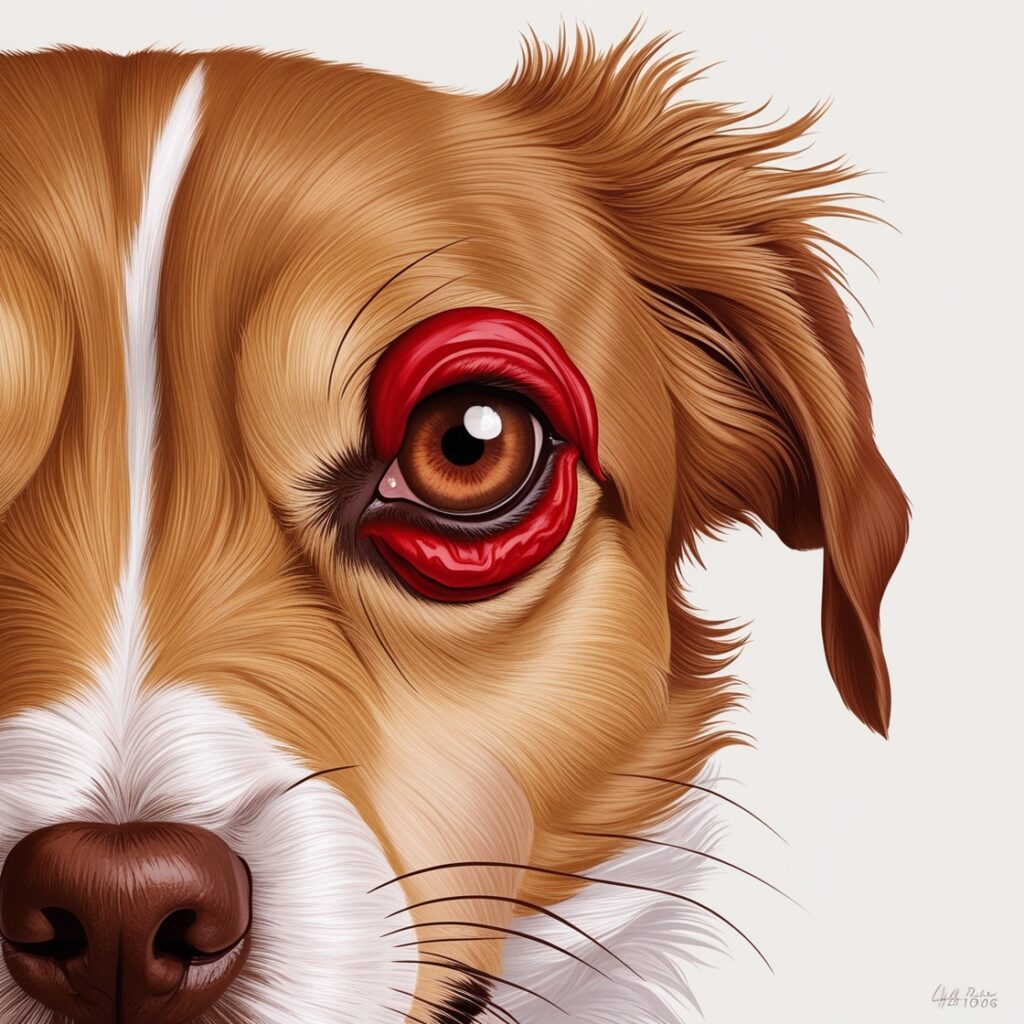Cherry Eye in Dogs though often unsettling—is a condition many dog owners may face. It’s essential for pet owners to understand this eye issue thoroughly, as prompt attention and care can prevent more severe complications down the road. This detailed guide will dive into the complexities of cherry eye, discussing its causes, symptoms, treatment options, and what you need to know for aftercare. By the end, you’ll have all the information required to manage this condition effectively and keep your dog’s eyes healthy.
What Is Cherry Eye in Dogs?
Cherry eye occurs when the third eyelid, also known as the nictitating membrane, prolapses or “pops out,” revealing a bright red or pink gland in the corner of the dog’s eye. This gland plays a crucial role in maintaining eye health by producing a significant amount of the eye’s tear film, which keeps the eye moist and nourished. When displaced, the gland can become irritated, leading to inflammation, dryness, or even infection if left untreated.
Causes of Cherry Eye: Why Does It Happen?
The origins of cherry eye remain unclear, but experts often attribute it to weak connective tissue that cannot hold the third eyelid gland in place.While it can affect dogs of any breed, certain breeds are more susceptible due to their unique anatomy.
- Brachycephalic Breeds: Bulldogs, Cocker Spaniels, and Beagles, with their short snouts and squished facial features, are often at a higher risk for cherry eye.
- Infection or Trauma: An eye infection or trauma can cause inflammation, which weakens the ligament that holds the third eyelid in place, making it more prone to prolapse.
In some cases, a combination of factors might contribute to the development of cherry eye.
Symptoms: How to Spot Cherry Eye
The first sign of cherry eye is usually the appearance of a pink or red mass in the corner of the affected eye, which can be alarming. However, other subtle signs might appear earlier, which can help with early detection:
- Redness and Irritation: The eye will often appear inflamed, and the affected dog may squint or appear in discomfort.
- Excessive Tearing: The prolapsed gland can lead to excessive watering or discharge from the eye.
- Difficulty Blinking: As the third eyelid becomes swollen or irritated, your dog may have trouble fully closing their eye, causing additional discomfort.
- Pawing at the Eye: Dogs may paw at their eye due to irritation or an instinct to remove the obstruction.
Treatment Options: How to Fix Cherry Eye
Dealing with cherry eye requires prompt and professional intervention to prevent complications like dry eye (keratoconjunctivitis sicca) or infections. There are several treatment options available, ranging from conservative approaches to surgical procedures.
Non-Surgical Treatment: Temporary Measures
- Manual Repositioning: In some cases, a veterinarian may manually reposition the gland back into place. However, this is often a temporary fix and may not prevent future occurrences.
- Anti-Inflammatory Medications: Medications can reduce swelling and irritation, offering some relief, but they don’t address the root cause—the gland’s prolapse.
Surgical Treatment: Long-Term Solution
Surgery is the most effective way to permanently address cherry eye, as it aims to secure the prolapsed gland back in place. There are two main surgical techniques:
- Tacking Surgery: A more common procedure where the gland is sutured back into its original position. This method aims to preserve the gland’s function, allowing it to continue producing tears.
- Gland Removal: Though sometimes necessary, this method is rarely recommended because it may lead to dry eye, a serious condition that affects tear production and overall eye health.
Aftercare and Recovery: Ensuring a Smooth Healing Process
Proper aftercare is vital after surgery to ensure the best possible recovery and prevent complications.
- Medications: Eye drops or ointments may be prescribed to control inflammation and prevent infections. These should be administered exactly as directed.
- Elizabethan Collar: An E-collar is essential to prevent your dog from pawing at their eye or rubbing it, which could interfere with healing.
- Follow-up Visits: Regular vet visits after surgery ensure that the gland heals properly and that your dog’s eye health is monitored.
It’s also important to keep your dog calm and avoid vigorous activities like running or playing, which could disturb the healing process.
Preventing Complications and Future Episodes
While some dogs may experience cherry eye more than once, there are measures you can take to minimize the risk of recurrence:
- Regular Check-ups: If you have a breed at risk for cherry eye, routine veterinary exams will help detect early signs of trouble.
- Addressing Eye Issues Promptly: If you notice any symptoms of eye irritation or redness, contact your vet right away to prevent further complications.
- Avoid Trauma: Be cautious with your dog’s eye area, avoiding rough play that could result in injury.
Diagram: How Cherry Eye Affects the Eye
mermaidCopy codegraph TD
A[Normal Eye Anatomy] --> B[Third Eyelid]
B --> C[Gland of the Third Eyelid]
A --> D[Cherry Eye Prolapse]
D -->|Leads to| E[Discomfort and Inflammation]
E -->|Requires| F[Treatment Options]
Conclusion: Managing Cherry Eye for a Healthier, Happier Dog
Cherry eye, while concerning, is not the end of the world for your dog’s eye health. With early intervention and appropriate treatment—especially surgical correction—you can ensure that your dog remains comfortable, healthy, and free from complications. Remember, the earlier you act, the better the outcome for your furry friend’s vision and quality of life.
For more detailed advice or if you suspect your dog has cherry eye, it’s always best to consult with a qualified veterinarian.



